Northeast Indiana: Realtors Region 3 Profile
Figure 1: Northeast Indiana: Realtors Region 3
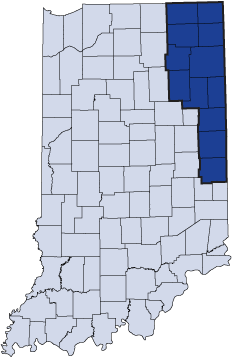
Source: IBRC, using the Indiana Association of Realtors definitions
This is the third article in our coverage of Indiana's Realtors regions. For an overview of this article series and a map of all six regions, see the first article at www.incontext.indiana.edu/2010/may-june/article5.asp.
Geography
Realtors Region 3 consists of 12 counties in northeastern Indiana and has an estimated population of 761,584 as of 2009. Counties in this region include Adams, Allen, DeKalb, Huntington, Jay, LaGrange, Noble, Randolph, Steuben, Wayne, Wells and Whitley (see Figure 1). This region covers a land area of 4,787 square miles and has a population density of 159 people per square mile, a density that is much higher than the national average of 88 people per square mile but lower than the Indiana average of 179 people per square mile.
Population
The largest city in Realtors Region 3 is Fort Wayne, with a 2009 population of 255,890. The city of Richmond comes in a distant second, with a population estimate of 36,569 (see Table 1).
Table 1: Largest Cities in Region 3, 2009
| Name | Population | Percent of Region |
|---|---|---|
| Fort Wayne | 255,890 | 33.6% |
| Richmond | 36,569 | 4.8% |
| Huntington | 16,828 | 2.2% |
| New Haven | 13,812 | 1.8% |
| Auburn | 13,084 | 1.7% |
| Kendallville | 10,561 | 1.4% |
| Decatur | 9,639 | 1.3% |
| Bluffton | 9,165 | 1.2% |
| Angola | 8,276 | 1.1% |
| Columbia City | 8,369 | 1.1% |
Source: IBRC, using U.S. Census Bureau data
The population in Realtors Region 3 increased between Census 2000 and the latest estimate in 2009 by nearly 25,000 people, a solid and positive change during this decade (see Figure 2). The population in Realtors Region 3 is projected to continue its growth through 2015, by which time its population would be close to 775,000 according to the official county population projections from the Indiana Business Research Center.
Figure 2: Region 3 Population Levels, 1981 to 2009
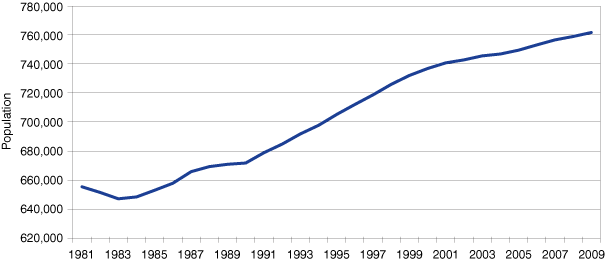
Source: IBRC, using U.S. Census Bureau data
This region has an age mix that differs slightly from the state’s mix (see Figure 3). The most notable difference is in the proportion of preschool and school age children. This region has a higher proportion of those two age groups (ages 0 to 4 and 5 to 17) than the state overall. However, the region has a lower proportion of college age and young adults while it is pretty much the same proportion as Indiana in terms of older adults and seniors.
Figure 3: Current Age Structure, 2009
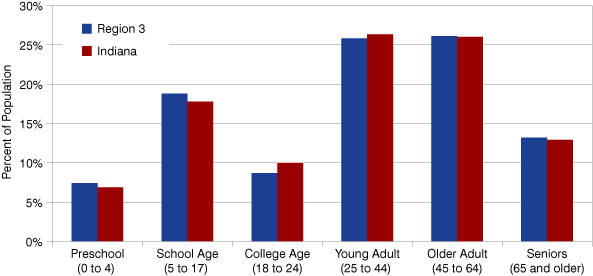
Source: IBRC, using U.S. Census Bureau data
Among the six Realtors regions, Region 3 ranks fourth in net migration from other nations, with 1,086 more people moving into the region from overseas or over-borders between 2008 and 2009 than moving out. The region had a domestic net loss of 2,903 people—that is, out-migration to other regions in Indiana or to other states between 2008 and 2009.
Almost 91 percent of the population is white, with 6.2 percent black (compared to the state’s 9.2 percent) and only 1.2 percent Asian, concentrated in Allen County. Nearly 5 percent of the region’s population is Hispanic, which is somewhat smaller than the statewide 5.5 percent in 2009.
Housing and Lifestyles
The region ranks fifth among the six regions with 333,100 housing units (2009 estimate). The majority of units, at least in 2000 when the last census was conducted, were owner-occupied. More than half of households in the region were married couples (25 percent with children, 30 percent without), 9 percent were single-parent households, and 26 percent lived alone.
Using aggregated data from the Indiana Association of Realtors database, which includes Multiple Listing Service (MLS) data from all counties but Wayne, we can look at recent home sales and a variety of characteristics of homes sold. In 2009, 7,253 homes were sold in the region. The median age of homes sold in 2009 was older in the region when compared to the state, with the largest number of homes built in 1959 or earlier (see Figure 4).
Figure 4: Homes Sold in 2009 by Year Built
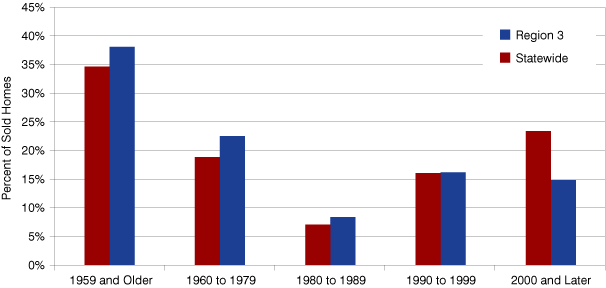
Note: Wayne County data not available.
Source: IBRC, using Indiana Association of Realtors data
Looking at individual counties in the region, there is a significant spread based on the median age of homes sold in 2009, with the oldest median ages in the counties of Huntington, Jay, Adams and Randolph (see Figure 5).
Figure 5: Median Age of Homes Sold in 2009 by County

Note: Wayne County data not available.
Source: IBRC, using Indiana Association of Realtors data
Of the homes sold in 2009, the vast majority of homes sold were priced under $150,000 and only a few were priced at $1 million or more. Using a statewide comparison, the region’s home sales occurred at a higher frequency in the ranges less than $100,000 (see Figure 6).
Figure 6: Cost of Homes Sold Compared to the State, 2009
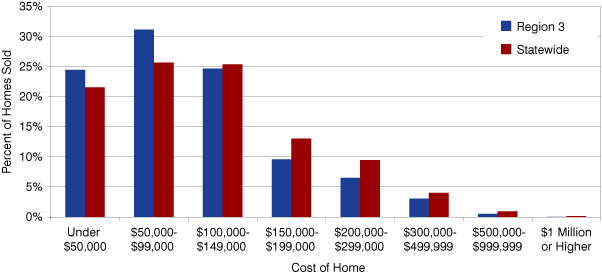
Note: Wayne County data not available.
Source: IBRC, using Indiana Association of Realtors data
Labor Force
As seen in Figure 7, 379,000 residents of the region are part of the labor force, with 335,000 people employed and the remaining 44,000 actively seeking work (i.e., unemployed) using the 2009 annual averages. The June 2010 unemployment rate for the region was 10.8, which was 7 percentage points higher than the state rate of 10.1 for that same month (not seasonally adjusted). For a closer inspection of labor force numbers, be sure to visit Hoosiers by the Numbers at www.hoosierdata.in.gov, the workforce development website of the Indiana Department of Workforce Development. These numbers come out monthly as preliminary estimates and the previous month's figures are revised.
Figure 7: Region 3 Resident Labor Force and Employment, 2009
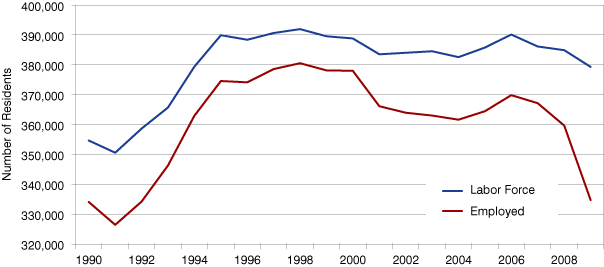
Note: Data are not seasonally adjusted.
Source: IBRC, using Indiana Department of Workforce Development data
Work
The vast majority of residents work in private industry or in what are called “nonfarm” jobs. The largest sectors in the region include manufacturing (68,000 jobs), retail (35,000) and health care and social services (33,000 jobs), as shown in Table 2.
Table 2: Realtors Region 3 Jobs by Industry, 2009
| Industry | Jobs | Jobs LQ |
|---|---|---|
| Total | 315,863 | 1.00 |
| Manufacturing | 68,106 | 2.34 |
| Retail Trade | 34,959 | 0.98 |
| Health Care and Social Services | 32,605 | 0.61 |
| Accommodation and Food Services | 27,344 | 0.86 |
| Admin. and Support and Waste Mgt. and Rem. Services | 15,690 | 0.75 |
| Wholesale Trade | 14,800 | 1.08 |
| Construction | 12,398 | 0.84 |
| Transportation and Warehousing | 11,874 | 0.92 |
| Finance and Insurance | 11,492 | 0.75 |
| Educational Services | 11,048 | 0.35 |
| Public Administration | 10,433 | 0.57 |
| Other Services(Except Public Administration) | 8,690 | 0.68 |
| Professional, Scientific, and Technical Services | 7,129 | 0.39 |
| Information | 5,393 | 0.75 |
| Arts, Entertainment, and Recreation | 3,027 | 0.49 |
| Real Estate and Rental and Leasing | 2,668 | 0.48 |
| Management of Companies and Enterprises | 1,614 | 0.35 |
| Utilities | 805 | 0.39 |
| Agriculture, Forestry, Fishing and Hunting | 492 | 0.18 |
| Mining | 151 | 0.10 |
Note: The employment numbers for some industries may be low due to nondisclosable data at the county level.
Source: IBRC, using U.S. Bureau of Labor Statistics data
Industry Clusters
Clusters can be a valuable way to organize our thinking about industry mix in an area. The Purdue Center for Regional Development has identified 17 industry clusters that give insight into the core industries and their supplier industries. The resulting data can help the region consider which are important or emerging clusters (see Table 3).
Table 3: Realtors Region 3 Industry Clusters, 2008
| Description | Cluster Establishments | Industry Cluster Establishment LQ |
|---|---|---|
| Total All Industries | 17,282 | 1 |
| Business and Financial Services | 2,320 | 0.86 |
| Energy (Fossil and Renewable) | 1,182 | 1.04 |
| Biomedical/Biotechnical (Life Sciences) | 947 | 2.25 |
| Manufacturing Supercluster | 752 | 2.83 |
| Advanced Materials | 619 | 2.3 |
| Information Technology and Telecommunications | 611 | 0.74 |
| Transportation and Logistics | 555 | 1.42 |
| Forest and Wood Products | 524 | 1.4 |
| Arts, Entertainment, Recreation and Vistor Industries | 486 | 0.96 |
| Education and Knowledge Creation | 458 | 1.23 |
| Defense and Security | 441 | 0.77 |
| Agribusiness, Food Processing and Technology | 397 | 1.44 |
| Printing and Publishing | 368 | 0.97 |
| Fabricated Metal Product Manufacturing* | 322 | 2.77 |
| Chemicals and Chemical-Based Products | 222 | 1.65 |
| Machinery Manufacturing* | 200 | 3.44 |
| Apparel and Textiles | 144 | 0.92 |
| Transportation Equipment Manufacturing* | 115 | 3.9 |
| Glass and Ceramics | 90 | 2.17 |
| Primary Metal Manufacturing* | 47 | 4.1 |
| Mining | 40 | 1.75 |
| Computer and Electronic Product Manufacturing* | 34 | 0.94 |
| Electrical Equipment, Appliance and Component Manufacturing* | 34 | 2.42 |
*These are subclusters within the manufacturing supercluster.
Source: IBRC, using U.S. Bureau of Labor Statistics and Purdue Center for Regional Development data
In using the table, it’s worthwhile to consider the actual number of establishments shown. We always want to know “volume” or just plain “how many.” But of equal value is the location quotient (LQ) provided in the column next to the numbers of firms. Anything over 1.0 means the region has export capacity—exporting to their neighbors in another region, another state, across the nation or around the globe. The idea of producing “more than we need” indicates that those clusters are serving needs outside the region as well as within its borders. In short, having an LQ higher than 1.0 is good; if it is a lot higher (as in, say, primary metals), then the cluster is quite strong.
If clusters have piqued your interest, be sure to turn your browser to www.statsamerica.org/innovation to see these data in action for areas throughout Indiana and in comparison to the rest of the country.
Time to Explore
We hope to have given you a fast trek through the numbers. We could go on, but then that might spoil your fun in going to STATS Indiana’s IN Depth Profiles and learning more about this region or the whole host of regions we have available.
Carol O. Rogers
Deputy Director, Indiana Business Research Center, Indiana University Kelley School of Business
